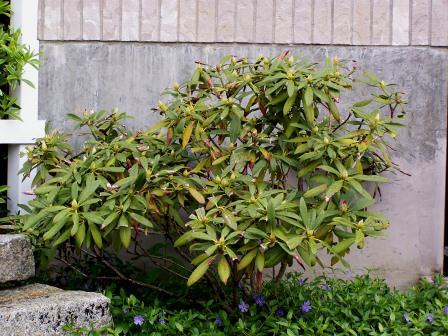Bert’s post yesterday inspired me to share one of my own timelines that I followed for 7 years. As many of you know, I am a proponent of bare-rooting container and B&B shrubs and trees. One of the benefits is that you can prune away malformed roots, but another is that you can ensure the roots come into contact with the native soil as soon as possible. It’s interesting to see what happens over time with the more typical “pop and drop” method.
I saw this rhododendron being planted in 2002. If you look closely, you can see that it was originally balled and burlapped – the burlap is up around the multiple trunks. Then the burlapped bag was put inside a contained filled with media. You can see that, too. So a hole was dug that exactly mirrored the plastic container and the whole works was lifted out and plugged in.
Visualize a giant jawbreaker with different colored layers. At the center, we have the roots surrounded by clay. This is encased in burlap and twine. Then there’s a layer of container media. And finally we have the native soil. Rather than making it easy for this rhododendron to get established, we now have several barriers for new roots to overcome.
The primary problem here is all of the different textures of stuff in this planting hole: clay, soilless media, and native soil. Water doesn’t move easily through different soil types (remember Jeff’s demo on drainage?) and if water doesn’t move, neither will the roots. And as you follow this time line, it becomes quite apparent that the roots never established into the native soil. Look in particular at the size of the leaves (they are markedly smaller as time goes on – a great indicator of chronic drought stress). The line in the masonry wall makes it easy to see changes in height – or lack thereof.

Installed in 2002 (year 0)



Early 2007 (Year 5)

People really have no idea…we need to help them with the basics.
Donna, I agree…but many nurseries still insist that the rootball not be disturbed or you lose your warranty. What’s a poor gardener to do???
This may be inappropriate, but I need some advice. I’m supposed to pick out a tree tomorrow at the tree nursery. I want an Arbutus “Marina”. I’m told that I
‘m in luck because the recent economic downturn has resulted in a glutt of trees that have been languishing in their boxes. Everybody is urging me to go for the biggest box that I can afford to plant, but my gut says go for a smaller tree. I’ve already won the amendment battle with the contracter who’s a general coontractor who likes to garden. The Bobcat is sitting in my backyard right now. I think they’ll freak if I want to bareroot the tree (I pot citrus after barerooting and they do fine). How do I check for root bound trees in something that I can’t knock out of the pot?
I can’t wait to show this to my class tomorrow. I was trying to explain Ball and Burlap and why we cut the top off of the B&B and not the bottom. Thanks for the pics
Linda,
I’ve seen you mention bare-rooting several places, but haven’t seen you detail your method. Do you use a hose, hand tools, a combination or none of?
Would love to see you write up the process, both for shrubs and trees. Thanks!
I would also like to hear more about bare rooting. In my annual Fall/Winter rearrangement of landscape plants I have noticed some terrible planting jobs I’ve done in the past, mostly in allowing roots to tangle and circle around themselves. I have also noticed that some large hollies I pulled, basically bare root, from the ground seem to be doing fine in the neighboring apartment property to where they were ‘donated’.
John and Bill, I’ve uploaded a slide presentation into Slideshare under LindaCS. Here’s the link: http://www.slideshare.net/LindaCS/bare-root-primer.
@J Bean, it’s really difficult to assess roots. Here are some things to avoid: pots that are obviously too small compared to the size of the trunk, surface roots of any sort, and suckering from the base.
Your gut is smart. Anything that’s large and has been sitting around the nursery for a while is going to have some root issues. That being said, you can correct problems once you’ve got the root ball open. If you can get a good deal on a tree, it’s worth doing the root wash and correcting problems. Be sure to watch the bare root presentation I put up on Slideshare under LindaCS.
Thanks for the slideshow!!
J Bean, I bought a couple of A. ‘Marina’s, from different sources,that had pure sawdust under the outer layer of soil. I don’t know if that’s common practice, but if I’d bare rooted them, I’d still have them.
I do have a question about plants, like magnolias, that are said to resent root disturbance. Does one still bare root them?
The slideshow was very helpful. Thanks so much.
Are my eyes deceiving me…. what is the ground cover in the last photo?
Linda, great post, and great slide show! The more detailed information gets out there about how to plant, the better for those poor plants…The big challenge for bare-rooting nursery stock is being brave enough to do it knowing that unpackaging the plant will void the warranty, which seems ridiculous, when keeping the packaging (and conditions inside all that burlap and wire and twine) may well spell the decline and early death of a plant.